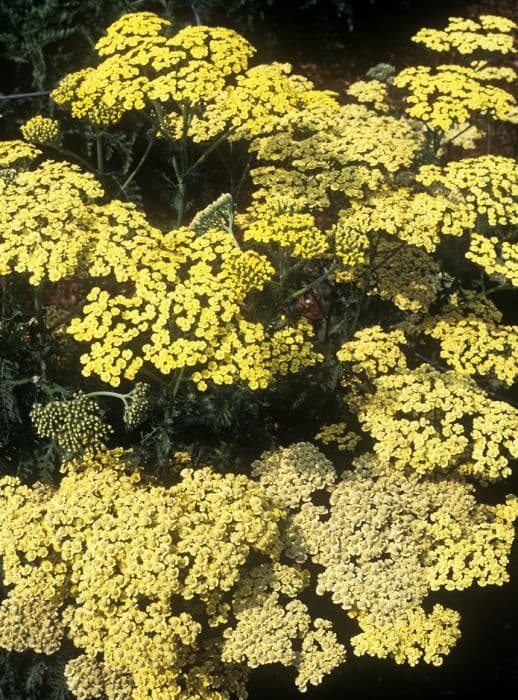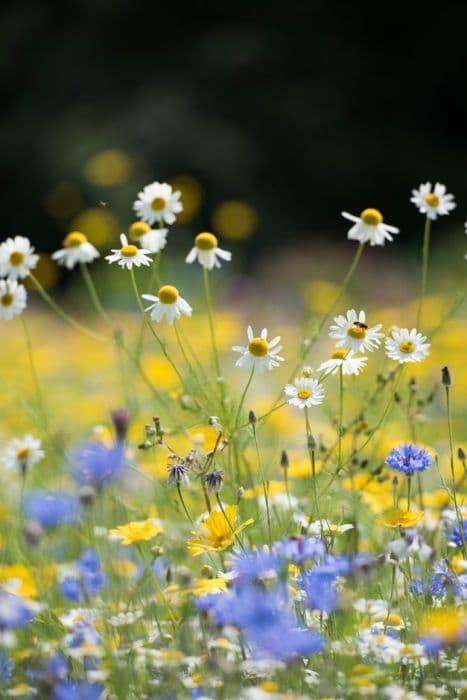African Daisy Osteospermum 'Sunny Mary' (PBR) (Sunny Series)

ABOUT
Osteospermum 'Sunny Mary' (PBR) (Sunny Series), commonly known as African Daisy, is a plant recognized for its appealing aesthetic. This variety features daisy-like flowers that are a cheerful attraction in any garden space. Each blossom displays a unique combination of colors, typically showcasing a vibrant yellow hue that radiates from the center and transitions to a softer, lighter shade towards the petal edges, creating a gradient effect reminiscent of the morning sun. The petals are narrow, elongated, and slightly recurved, which adds to the dynamic appearance of the flower. These flowers are prominent and sit atop lush foliage that presents a dense and bushy collection of green leaves. The leaves have a slightly glossy texture that adds an extra layer of visual interest to the plant. Together, the colorful and bright blossoms contrast with the greenery, giving the African Daisy a striking and delightful presence in gardens and containers. Its overall form can be described as compact and rounded, contributing to its neat and tidy appearance. Despite its common name, it should not be confused with true daisies and it brings a distinctive look to any ornamental setting where it is planted.
About this plant
 Names
NamesFamily
Asteraceae
Synonyms
African Daisy, South African Daisy, Cape Daisy, Blue-Eyed Daisy
Common names
Osteospermum 'Sunny Mary' (PBR) (Sunny Series).
 Toxicity
ToxicityTo humans
African daisy is generally considered non-toxic to humans. There are no well-documented cases of poisoning from ingesting this plant. Consequently, there are no specific symptoms associated with poisoning because it is not known to be poisonous. However, as with any plant, individual allergies or sensitivities can occur, and it is always advised to exercise caution and avoid ingesting plants that are not specifically meant for consumption.
To pets
African daisy is not known to be toxic to pets. It is not listed among plants that are commonly recognized as poisonous to animals such as dogs and cats. Therefore, there are no specific symptoms associated with poisoning from ingesting this plant in pets. As with humans, pets can sometimes have allergies or sensitivities to plants, so it is wise to prevent your pets from eating ornamental plants and to monitor them for any signs of distress if they do consume any part of the plant.
 Characteristics
CharacteristicsLife cycle
Perennials
Foliage type
Evergreen
Color of leaves
Green
Flower color
Yellow
Height
1 feet 2 inches (35 cm)
Spread
1 feet 2 inches (35 cm)
Plant type
Herb
Hardiness zones
9
Native area
South Africa
Benefits
 General Benefits
General Benefits- Aesthetic Appeal: Osteospermum 'Sunny Mary' adds vibrant color to gardens with its bright yellow flowers that have a striking dark purple eye.
- Extended Blooming: This plant typically has a long flowering season, from spring to fall, providing continued visual interest.
- Drought Tolerance: Once established, it is relatively drought tolerant, making it suitable for low-water gardens and reducing the need for frequent watering.
- Attracts Pollinators: The flowers attract bees and butterflies, which are essential for pollination and maintaining healthy ecosystems.
- Low Maintenance: 'Sunny Mary' is generally easy to care for and does not require complex gardening skills, making it ideal for novice gardeners.
- Versatility: Suitable for borders, containers, and as ground cover, this plant can be used in various garden designs and settings.
- Fast Growing: It can establish and cover an area quickly, providing a full and lush display in a relatively short period.
- Resistant to Pests and Diseases: This variety of Osteospermum is typically resistant to many common pests and diseases, reducing the need for chemical treatments.
 Medical Properties
Medical PropertiesThis plant is not used for medical purposes.
 Air-purifying Qualities
Air-purifying QualitiesThis plant is not specifically known for air purifying qualities.
 Other Uses
Other Uses- Photography props: The Osteospermum 'Sunny Mary' can serve as a vibrant and colorful subject for macro and still life photography, enhancing the visual appeal of the composition.
- Creative arts and crafts: Its flowers can be used to make floral arrangements, pressed flower art, or be incorporated into eco-friendly confetti for celebrations.
- Educational tool: Botany educators can use the plant to teach students about plant growth, hybrid species, and pollination in hands-on learning experiences.
- Theme gardens: This plant can be used to create a 'sunshine' themed garden area, combining various sun-loving plants to represent the theme of warmth and positivity.
- Fabric dye: The bright petals of the Osteospermum 'Sunny Mary' may be used to create natural dyes for fabrics and textiles.
- Culinary decoration: Although not traditionally edible, the petals can be used for decorative purposes on cakes and desserts if properly cleaned and ensured to be free of chemicals.
- Candle making: The dried flowers can be embedded into the wax of handmade candles to add a unique floral aesthetic.
- Seasonal festivals: The plant can be featured in displays and flower shows, especially during spring and summer festivals or garden competitions.
- Literary inspiration: Gardeners and writers can draw inspiration from the beauty of the plant for poetry, stories, and other creative writing pieces.
- Scented sachets: Dried Osteospermum 'Sunny Mary' flowers can be included in potpourri or scented sachets to impart a mild fragrance to linens and drawers.
Interesting Facts
 Feng Shui
Feng ShuiThe African Daisy is not used in Feng Shui practice.
 Zodiac Sign Compitability
Zodiac Sign CompitabilityThe African Daisy is not used in astrology practice.
 Plant Symbolism
Plant Symbolism- Beauty: Osteospermum, commonly known as the African Daisy, is renowned for its stunning daisy-like flowers, symbolizing both natural beauty and the ability to stand out in a crowd with grace.
- Cheerfulness: With its sunny and bright appearance, the African Daisy often represents cheerfulness and positive energy, bringing to mind the radiance of a sunny day.
- Perseverance: As a plant that can thrive in tough conditions, it can symbolize the ability to endure and persevere through difficulties.
- New Beginnings: The African Daisy blooms in the morning, hence it is frequently associated with new beginnings, freshness, and the start of a new journey.
- Protection: In some cultures, the African Daisy is believed to symbolize protection due to its hardy nature and its ability to grow in challenging environments.
 Water
WaterThe African Daisy should be watered regularly, allowing the top inch of soil to dry out between waterings. It's important not to overwater as this can lead to root rot. A good approach is to provide a thorough watering once every week, adjusting based on weather conditions and the plant's environment. In terms of the amount, each watering session might involve about 16 to 32 ounces of water, depending on the size of the plant and the pot. Monitor the plant's response to watering and adjust as necessary for optimal health.
 Light
LightThe African Daisy thrives best in full sun conditions, meaning it should receive at least six to eight hours of direct sunlight daily. Place it in a spot where it is exposed to unfiltered sunlight for most of the day, such as a south-facing window when grown indoors, or an open garden bed without shade if outdoors. This light exposure is crucial for the plant to produce its vibrant flowers.
 Temperature
TemperatureAfrican Daisy prefers a temperate climate with temperatures ranging between 50°F and 75°F. The plant can endure minimum temperatures down to around 30°F but should be protected from frost. The ideal temperature for optimal growth and flowering is between 60°F and 70°F.
 Pruning
PruningPruning the African Daisy helps encourage bushier growth and more blooms. Deadhead spent flowers regularly to stimulate new bud formation. A more thorough pruning can be done in early spring or after the main flowering period to rejuvenate the plant. Cut back about one-third of the plant's size to maintain its shape and improve its vigour.
 Cleaning
CleaningAs needed
 Soil
SoilAfrican daisy 'Sunny Mary' thrives in well-draining soil enriched with organic matter. A mix of loam, peat, and sharp sand in equal parts is ideal. The optimal soil pH is between 5.5 and 6.0.
 Repotting
RepottingAfrican daisies like 'Sunny Mary' usually don't need frequent repotting and can be done every 2-3 years or if the plant outgrows its container.
 Humidity & Misting
Humidity & MistingAfrican daisy 'Sunny Mary' prefers moderate humidity levels, typical of outdoor environments, without special requirements for increased humidity indoors.
 Suitable locations
Suitable locationsIndoor
Place in sunny spot with occasional watering.
Outdoor
Full sun to partial shade in well-draining soil.
Hardiness zone
9-11 USDA
 Life cycle
Life cycleOsteospermum 'Sunny Mary', commonly known as African Daisy, begins its life cycle as a seed or may be propagated from cuttings. Upon germination or rooting, the plant enters its vegetative stage, developing leaves and stems as it matures. During the growth phase, regular watering and exposure to full sunlight encourage robust health and prepares it for flowering. African Daisy typically flowers from early spring to fall, showcasing daisy-like flowers with vibrant colors that are attractive to pollinators. After pollination, the flowers fade and the plant sets seed, completing its reproductive cycle. In perennial growing zones, the plant will become dormant in winter, surviving as a root system before resprouting in spring; in non-perennial zones, it is often grown as an annual and will end its life after seeding.
 Propogation
PropogationPropogation time
Spring-Early Summer
Osteospermum 'Sunny Mary' (PBR), commonly known as African Daisy, is typically propagated through stem cuttings, which is the most popular method for this particular cultivar. This is best done in late spring or early summer when the plant is actively growing. To propagate, a healthy, non-flowering stem is selected and a cutting of about 4 to 6 inches (10 to 15 cm) long is taken. The lower leaves are removed, and the cut end is dipped in a rooting hormone to encourage root development. The cutting is then placed in a well-draining potting mix and kept in a warm environment with indirect sunlight. The medium should be kept moist but not overly wet to avoid rot. Within a few weeks, roots should form, and after a strong root system is established, the new African Daisy plant can be transplanted to a permanent location.









